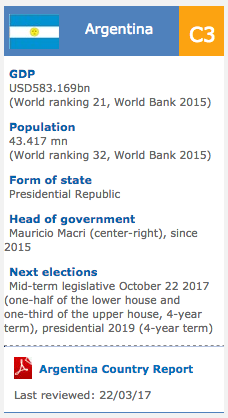General Information
|
|
GDP |
USD1339.5bn (World ranking 12, World Bank 2015) |
|
Population |
23.8mn (World ranking 53, World Bank 2015) |
|
Form of state |
Federal Parliamentary Democracy (Commonwealth) |
|
Head of government |
Malcolm Turnbull |
|
Next elections |
2019, Federal elections |
Country Rating AA1
|
Strengths
-
Large natural resource endowments
-
Strong infrastructure and business environment
-
Proximity with Emerging Asia
-
Strong economic performance
|
Weaknesses
-
Dependent on Chinese demand and commodity prices
-
Highly vulnerable to change in climate
-
External vulnerabilities stem from chronic current account deficit and high external debt
-
High household debt
|
Economic Overview
Subpar growth ahead
The Australian economy is set to grow below-trend at only 2% to 2.5% real GDP in 2017.
After a strong first semester, the economy has slowed markedly in the second half of 2016. The subdued performance was due to weak growth in investment - both public and private - and lower government consumption. Private consumption remained resilient. Net exports underperformed due to lower exports compared to imports.
Going forward, private investment growth is set to remain weak. This reflects a structural adjustment following the end of the mining boom, pressured corporate profits, and modest prospects for the non-mining sector. Exports growth will be constrained by a limited increase in global demand on the back of modest growth in China and high-income markets.
Back at home, private consumption should prove quite firm thanks to contained inflation and a resilient labor market. Yet any acceleration is off the cards. The culprit, in this case, is high leverage. Household debt accounts for 186% of disposable income. One should expect policymakers to phase out easing measures. A favorable policy mix combining lower credit cost for companies and supportive fiscal measures would allow gradual growth acceleration.
A favorable policy mix
Expectations are that the central bank will maintain its cautious easing stance to support the economy. Inflationary pressures are low, and only a modest uptick is expected next year due to a slight increase in commodity prices. However, debt and housing-related risks can impact banks and households’ balance sheets and limit the space for maneuvering. On the currency front, downward pressures would continue to stem from a diverging monetary policy with the US and subpar economic performance.
On the fiscal side, the rate of consolidation might be lowered. Public finances are sound with low debt and lower deficit compared to other high-income economies. While the current stance aims to consolidate public finances and reach a fiscal surplus by 2020, the government is set to adopt a flexible stance. It may tolerate deviation from the current targets of -2.2% of GDP for the financial year 2016-17, and -1% for 2017-18. Possible means to this end could include a corporate tax cut, added infrastructure spending, and more inclusive growth-supportive measures.
External vulnerabilities are manageable
The current account deficit remains elevated although it has somewhat improved in 2016 thanks to a bounce back in commodity prices. Looking ahead, export diversification, firmer external demand, and progressive commodity price normalization should allow a gradual reduction in the deficit in 2017. Australia’s external debt is still high and stands above 100% of GDP. Policy buffers such as low public debt, favorable investors’ confidence, and relatively positive economic outlook (compared to other high income economies) should help contain sustainability risks in the short run.

















